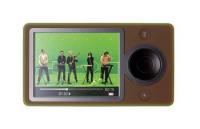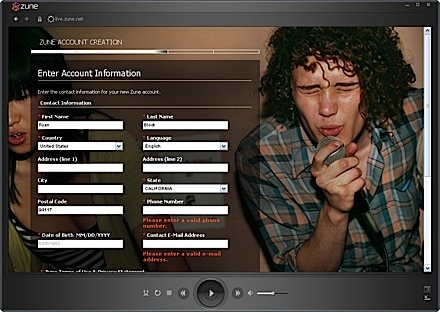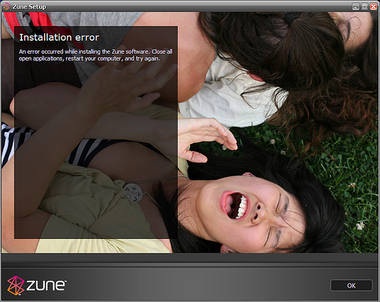Zooooooooon
 The ZuneDo you hear that sound? That’s what Apple shaking in its boots sounds like. With the Zune, Microsoft enters the personal music player fray, diversifying further into the hardward market. It’s like an iPod, but it’s not from Apple; it’s from a company you can trust.
The ZuneDo you hear that sound? That’s what Apple shaking in its boots sounds like. With the Zune, Microsoft enters the personal music player fray, diversifying further into the hardward market. It’s like an iPod, but it’s not from Apple; it’s from a company you can trust.
It was accidentally released a tad earlier than expected, but that alone can’t explain the way it’s stumbled from the starting blocks, tripped over its own shoelaces and face-planted into the tarmac. The trouble started with the initial still pictures of the device—geek porn, as it were. It looks a lot like an iPod, playes video, has a 30GB hard drive and even sports wireless capabilities. It comes in white and black and, to be innovative, brown.
Brown
The alternate color choice was somehow wrong, as captured by the following quote from The Problem Is, The Zune Is Brown by Anil Dash:
“In person, the device has a rich, warm color. The green tinge is innovative; I’ve never seen a consumer electronics device that tries for such a complicated, organic palette, and it’s pulled off wonderfully. But instead of calling the color chocolate, or something else compelling and attractive, they named it brown, a color that has few positive associations…”
Regardless of nitpicking about marketing of the device and its color array, let’s get a favorable review in here. Sharing the Sharing (3hive) likes the brown as well:
“My favorite color is the brown. The pictures don’t do it justice. But when you’re holding it in your hand there’s this warm, vintage look to it, like you’re cuddled up to your grandparents’ hi-fi, dropping needle to Herb Alpert groove.”
Essentially, the device looks cool in brown.[1] Microsoft’s marketing department, however, is just incredibly ham-handed when compared to the current market leader. And that’s just it: with Apple already doing such a slick job, how is it possible for Microsoft, with its troughs of cash, to fail to knock our socks off (once again)? It’s not even that. It’s not even achieving adequacy. People are laughing.
Continuing in this vein is a recent report called Microsoft’s Zune released (CNN). The link leads to a video showing a review that veers quickly from the Zune to the iPod. It begins with a quick rundown of the salient features, including the Zune’s lone distinguishing innovation—the ability to beam songs to other Zunes. Even this feature is covered in a none-too-flattering manner, detailing the short sharing period—three days or three plays, where a play is counted as soon as you start listening—and the fact that you have to ask to download the song in meatspace.
After this introduction, the reviewer is asked:
[CNN anchor] Who do they think is going to buy this? … Can I show you my new Shuffle?
[reviewer] You see now that’s the thing right there … that’s a lot sexier than this [Zune]
[CNN anchor] Look at this: it weighs nothing, literally the size of a matchbook and weighs as much … 70 something bucks!
[reviewer] Microsoft will, in the end, come out with something … well, I don’t know if it will be that pretty … isn’t that neat? My God …
[other anchor] Why don’t they get some decent design people that can make things look better? It’s clunky. …
Jesus. And these are people being paid to chat up the Zune—not like the reviews written by die-hard Apple fans circling in the waters, smelling blood from a mile away.
Wireless and Sharing
Coming back to the wireless feature, as recently as the middle of september, J Allard Calls iPod the Pong of Digital Audio (Gizmodo), asked the head of the Zune team “…am I really going to troll Wifi for other people’s music? What is that going to do for battery life?” The response just two months ago was, “It’s a tough problem, and we’re not done with it yet.” Good luck with that, early-adopters of the Zune—the wireless feature sounds like typical Microsoft 1.0 stuff. And the song-sharing is even more limited than you thought, because:
“The drawback to the sharing function is that ALL MP3s get chained with DRM. … even [if] the band wants you to have it no strings attached, you only have three plays/days to enjoy it. After that, you’ll have to go download it yourself.”
So, essentially, have fun scrambling to keep the device charged and have fun scrambling to keep the Zune from deleting your music.
Getting Installed
As expected, Microsoft has released plugins for iTunes and WinAMP (with other to follow) that integrate and synchronize the Zune with popular music players. Yeah, right. They’ve got their very own player, with their very own installer and their very own music service. In fact, as mentioned in the CNN review, music you already bought from MSN or Napster or Apple will not work with the Zune or its software. In fact, according to MSN Music to go silent once Zune launches (Ars Technica), all existing users will have to start shopping in the Zune Marketplace.
Since it’s Microsoft 1.0 software, it’s got a few rough edges. Even gadget freaks couldn’t forgive this alpha-quality stinkbomb: Installing the Zune… sucked (Engadget) has all the gory details. They wanted to like it:
“We hoped installing the Zune software and getting our player running would be as seamless and painless as getting iTunes and an iPod running on your machine, since that is, after all, what it’s up against.”
…but were treated to a nearly endless installation process, including a completely non-standard installer and minute-long pauses with no user feedback. The fun didn’t end there; it included such bumps in the road as the installer informing you that your brand-new Zune “already has a home on another PC” and crashing immediately if you do anything but “[c]onnect this Zune as a guest”. Things continue in this vein as Windows refuses to plug-and-play nicely for a few attempts before you’re allowed to try installing again. The installer informs the user several times that all settings can be adjusted later in the options, but the reviewer couldn’t get the options to show up at all: the software crashed every time.[2]
Update: The Zune Review (Engadget) is a comprehensive look at the device and its software. The battery life capped out at around 12 hours with wireless enabled, but no actual sharing of files. The software? “Was it still buggy? Yes. Did it still crash? Absolutely. For example, syncing video for us crashed the app twice, and then stalled the third time at 38%.” Tens of thousands of engineers and not a single one of them can get the software for their flagship product to do the basics expected of a media application? Are you kidding? How about plug-and play? C’mon on, Microsoft! You can do it!
“Never before have we done so much device plugging and unplugging. When you finish adding files to your Zune, you can’t go back and drop in more. You cannot interact with your player until you unplug it, and plug it back in. While it’s plugged in you can’t interact with it; with the Zune there’s no such thing as listening to music out of the player and charging via the sync cable at the same time. We couldn’t play music off the device through the application, either. When your Zune is plugged in, your Zune is absolutely nothing but plugged in.”
Ouch.
There’s a lot more information—including some actually positive comments sprinkled throughout the review—and there are a lot more pictures—including side-by-side comparisons with the current iPod generation.
Oh, and one more thing, Zune incompatible with Windows Vista (Apple Insider). Way to coördinate your product line, Microsoft.
Branding
The installation includes lots of big, splashy background graphics of cool kids doing wicked cool things, overlaid by suchy pithy phrases as “Welcome to the social” and “Free your inner dj”. Who exactly is their target market? People who like using installers? Why does Microsoft love the idea of installing? They jazz it up so much that you can’t ignore it. Contrast that to the Apple approach, which makes installation so innocuous that you’re using the application before you know it.
Here’s a peek at the installer:
 Karaoke is Cool
Karaoke is Cool
Wow! Microsoft thinks that guy is cool? Exactly which kind of market identifies with this? Not only that, but that’s the mandatory registration form—claims that it’s optional were not borne out, as the software crashed without a word when used without registering. Note that the phone number is not an optional field. Wheeee!
Other parts of the installer were a bit scarier, as reported in Zune install screen raises eyebrows. The installation error screen looks like this:
“Are we meant to think of this girl as singing along excitedly to a song that’s being played on loud speakers as she’s clearly not carrying a Zune and has no earbuds in? Maybe. … Is this girl in excruciating pain, perhaps someone is jabbing her with a pitchfork or some terrible music is playing … [or] Could it be that the girl is being pleasured by an off-screen person (her own hands are visible) and that she is bordering on a hefty orgasm?”
And you thought open-source software had weird branding.
Buying Songs
Buying songs is also not so straightforward, as Microsoft only accepts their own currency, not cash. You can’t just plunk down 99 cents for a song, paying with a credit card. You have to open an account and buy a block of points, which can be used to purchase content. On top of that, you can only buy points in $5, $15, $25 or $50 amounts. Zune Marketplace’s Absurd Pricing Scheme by James R. Stoup gives more detail:
“You see, when you buy these ‘points’ you can’t buy them as you need them, you have to purchase them in Microsoft defined denominations. In other words, Microsoft just invented a currency and they require you to invest in this currency before they can sell you any music. … In effect, Microsoft has created a store that only accepts gift cards as the valid method of payments. And if you don’t think thats insane then you obviously already have pre-ordered your Zune.”
It’s pretty clear from all this that Microsoft has a deep-seated disdain for its customers. Even the exchange rate for points is ridiculous: it’s currently pegged at $1.25 per 100 points, so a 79 point song is—you guess it—about $.99, just like the iTunes store. Microsoft also apparently thinks people are resoundingly dumb, as well. Seeing as how Windows has a 95% lock on the OS market, they have every right to think that.[3]
Conclusion
The Zune is “clunky”, the software “sucks”, wireless support is “not … done” yet, and you have to invest in “Microsoft points” to buy songs, which disappear after “3 days” when shared.
But brown is cool.
Oh yeah, and one last thing. The rollout? Managed to perfection.[4]
